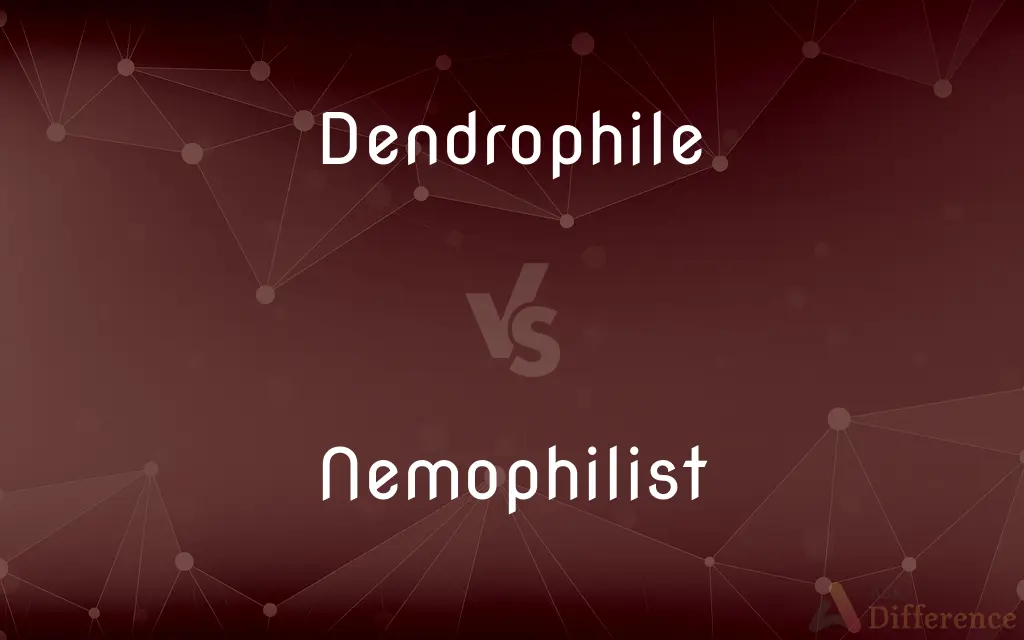Dendrophile vs. Nemophilist — What's the Difference?
By Tayyaba Rehman & Maham Liaqat — Updated on March 25, 2024
A dendrophile has a love for trees, whereas a nemophilist finds solace and joy in the forest.

Difference Between Dendrophile and Nemophilist
Table of Contents
ADVERTISEMENT
Key Differences
Dendrophile refers to an individual with a profound affection or love for trees, often passionate about their beauty, conservation, and the role they play in nature. This term emphasizes the connection one feels specifically towards trees, whether for their aesthetic, ecological, or symbolic significance. In contrast, a nemophilist is someone who loves forests and wooded areas, appreciating the dense canopy, biodiversity, and the sense of peace forests provide. The focus is broader than just the trees, encompassing the entire forest environment.
The perspective of a dendrophile might include a fascination with the individual characteristics of trees, such as their species, age, and the unique story each tree tells through its growth rings and structure. Dendrophiles may engage in activities like tree planting, advocacy for forest conservation, and educational efforts to share the importance of trees in ecosystems. On the other hand, nemophilists are drawn to the experience of being within the forest, relishing in the tranquility, the sound of rustling leaves, and the interconnectedness of forest life. Their interest may lead them to hiking, bird watching, and other activities that immerse them in the forest setting.
While dendrophiles may focus on the preservation and appreciation of individual trees, their significance in urban settings, and their role in combating climate change, nemophilists appreciate the forest for its aesthetic beauty, its ability to inspire, and its importance as a habitat for a wide range of wildlife. The approach of a nemophilist is more about the ambiance and the therapeutic benefits of being in a natural, wooded environment.
The love a dendrophile has for trees can be seen as a component of the broader affection a nemophilist has for forests. While a dendrophile might marvel at the majesty of a singular ancient tree, a nemophilist finds joy in the collective beauty of a forest and the mystery it holds. This distinction highlights the different ways people connect with nature, whether through a specific element like trees or the wider context of a forest.
In terms of advocacy and environmental activism, dendrophiles might be more involved in specific initiatives related to tree conservation, such as campaigns against deforestation, urban tree planting projects, or educational programs about the importance of trees in maintaining ecological balance. Nemophilists, while also likely to engage in conservation efforts, may focus their energies on preserving large areas of natural woodland, supporting national parks, and promoting practices that protect forest ecosystems as a whole.
ADVERTISEMENT
Comparison Chart
Focus
Love for trees
Love for forests and wooded areas
Activities
Tree planting, conservation advocacy, education on trees
Hiking, bird watching, enjoying the tranquility of forests
Interest
Species, age, and stories of individual trees
The ambiance, biodiversity, and therapeutic benefits of forests
Advocacy
Tree conservation, urban greening, combating climate change
Forest preservation, national park support, ecosystem protection
Connection
Specific to trees and their ecological and symbolic significance
Broader, encompassing the entire forest environment
Compare with Definitions
Dendrophile
Someone passionate about tree conservation.
He wrote articles on the importance of urban trees, showcasing his dendrophilia.
Nemophilist
A person who loves forests and finds peace in wooded areas.
Weekends found the nemophilist exploring secluded forest trails.
Dendrophile
An individual with a deep appreciation for trees.
As a dendrophile, she volunteered for tree planting weekends every season.
Nemophilist
Finds joy in the ambiance and biodiversity of forests.
His happiest moments were when he was surrounded by the dense canopy of the forest.
Dendrophile
Engages in activities to protect and celebrate trees.
They organized a community event to celebrate Arbor Day, a dendrophile's favorite holiday.
Nemophilist
Advocates for the preservation of forests and natural woodland.
He campaigned for the protection of local forests, driven by his love for these ecosystems.
Dendrophile
Finds beauty and interest in the details of trees.
Her collection of photographs captured the unique bark patterns of ancient trees.
Nemophilist
Engages in activities that immerse them in the forest setting.
As a nemophilist, she participated in birdwatching tours to deepen her connection with the forest.
Dendrophile
Values trees for their ecological, aesthetic, and symbolic roles.
She studied botany to better understand the trees that she so loved.
Nemophilist
Appreciates forests for their therapeutic benefits and natural beauty.
The nemophilist wrote poetry inspired by the tranquility of the forest.
Dendrophile
One who loves trees.
Nemophilist
(rare) One who is fond of forests or forest scenery; a haunter of the woods.
Nemophilist
One who is fond of forest or forest scenery; a haunter of the woods.
Common Curiosities
Can someone be both a dendrophile and a nemophilist?
Yes, it's possible to have a deep appreciation for both individual trees and forests as a whole, embodying the qualities of both a dendrophile and a nemophilist.
How can I become a dendrophile or nemophilist?
Engaging with nature, learning about trees and forest ecosystems, and participating in conservation efforts can deepen your appreciation and connection to trees or forests.
Can urban areas support dendrophiles and nemophilists?
Yes, urban areas can support dendrophiles and nemophilists through urban forests, parks, tree-lined streets, and community gardens, providing green spaces for residents to connect with nature within a city setting.
Are there any specific careers for dendrophiles or nemophilists?
Careers that might appeal to dendrophiles and nemophilists include forestry, environmental science, conservation work, botany, landscape architecture, and environmental education, among others, which involve working with trees, forests, and natural landscapes.
Why are trees and forests important?
Trees and forests play critical roles in maintaining ecological balance, providing oxygen, supporting biodiversity, offering mental health benefits, and combating climate change.
Are dendrophilia and nemophilia recognized environmental movements?
While not formal movements, dendrophilia and nemophilia reflect a growing awareness and appreciation for the natural world, contributing to broader environmental advocacy and conservation efforts.
What can individuals do to support trees and forests?
Individuals can support trees and forests by participating in tree planting, advocating for conservation policies, supporting sustainable forestry practices, and educating others about the importance of these natural resources.
What's the difference between a forest and a woodland?
A forest typically refers to a large area covered predominantly with dense collections of trees, while a woodland is usually a smaller, less dense area of trees. Both terms, however, are often used interchangeably in casual conversation.
How does spending time with trees or forests benefit mental health?
Spending time in the presence of trees and forests can reduce stress, enhance mood, improve focus, and boost overall mental well-being, due to the calming effects of nature and the clean air provided by these environments.
How do dendrophiles and nemophilists contribute to biodiversity?
Dendrophiles and nemophilists contribute to biodiversity by advocating for the conservation of trees and forests, participating in restoration projects, and raising awareness about the importance of these ecosystems for supporting a wide range of plant and animal species.
Share Your Discovery

Previous Comparison
Converse vs. Conversant
Next Comparison
Naos vs. PronaosAuthor Spotlight
Written by
Tayyaba RehmanTayyaba Rehman is a distinguished writer, currently serving as a primary contributor to askdifference.com. As a researcher in semantics and etymology, Tayyaba's passion for the complexity of languages and their distinctions has found a perfect home on the platform. Tayyaba delves into the intricacies of language, distinguishing between commonly confused words and phrases, thereby providing clarity for readers worldwide.
Co-written by
Maham Liaqat













































